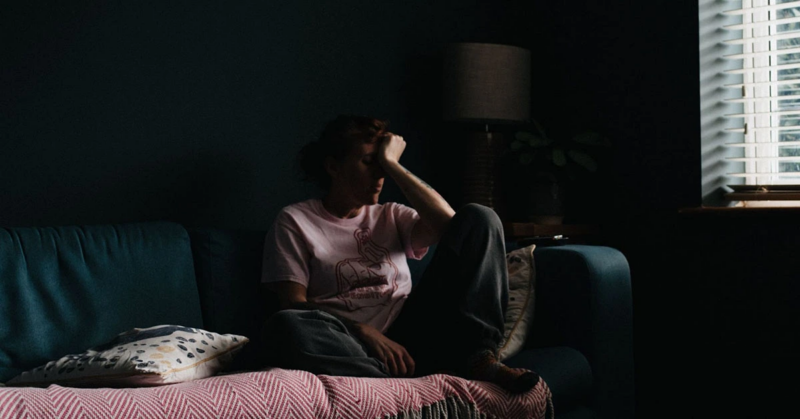
Table of Contents
What is Bipolar Depression?

Written By: Alex Bachert, MPH
May 9, 2022
6 min.
Bipolar disorder can pose significant mental health challenges for teens. We outline what causes bipolar depression, how to identify it, and treatment options.
Learn more about our Clinical Review Process
Table of Contents
Bipolar disorder is a mental health condition defined by dramatic and unpredictable mood swings, ranging from depressive lows to manic highs. There are four types of bipolar disorder—bipolar I, bipolar II, cyclothymic disorder, and unspecified bipolar—and each includes a depressive period where a person will feel sad, hopeless, and disinterested in life.
A 2013 report from the National Institute of Mental Health found that nearly three percent of adolescents were living with bipolar disorder, and 2.6 percent had severe impairment. Unlike other types of depression which tend to be more prevalent among females, the report showed an equal gender ratio for bipolar disorder.
Importantly, symptoms of bipolar depression are often first spotted around age 25, but signs can begin to show even during the teen years. Why does this matter? Because research suggests that many people won’t receive a diagnosis or treatment for six to eight years after onset of symptoms, with an even longer delay among juveniles.
Bipolar disorder is a lifelong condition and without proper support, the symptoms can make things like school, work, and relationships challenging. Here, we’ll review signs of a depressive episode, common causes of bipolar disorder, and treatment options to help you or a loved one live a fulfilling and balanced life.
Bipolar depression signs and symptoms
The nature of bipolar disorder is different person to person. For some, the highs and lows follow a consistent pattern while other people can live for years without experiencing any symptoms. There are four types of bipolar disorder, and they vary based on the frequency of mania (defined as an extremely elevated and excitable mood) and depression.
Bipolar I Disorder
The most severe form of the condition, bipolar I disorder is characterized by at least one manic episode lasting for seven days or more, or severe mania that requires hospitalization. Bipolar I disorder often includes major depressive episodes that last for two weeks or more.
Bipolar II Disorder
Bipolar II disorder includes periods of hypomania, a milder form of mania that doesn’t include psychotic episodes, and major depressive episodes. These low periods can occur before or after the manic episode.
Cyclothymic Disorder
Also known as cyclothymia, this form of bipolar disorder is described as a chronically unstable mood that lasts for at least two years. This means extended periods of hypomania and mild depression, with brief periods of normal mood that last for eight weeks or less.
Bipolar Disorder Unspecified
It’s possible to experience clinically significant abnormal moods without fitting into any of the above three categories. These cases are classified as “other specified” or “unspecified” bipolar disorder.
To classify as a depressive episode, several of the following symptoms must be present nearly every day for a period of at least two weeks.
- Feeling depressed, hopeless, or worthless
- Feeling lonely or isolating yourself from others
- Feeling lethargic
- Sleeping too much
- Eating too much or too little
- Speaking very slowly
- Disinterest in usual activities and hobbies
- Thoughts of death or suicide
- Forgetfulness
- Inability to handle simple tasks

Bipolar depression causes and risk factors
Similar to other depressive disorders that affect teens and adolescents, there’s no single cause of bipolar depression. Instead, it’s likely a collection of reasons that contribute to a person’s symptoms. Two of the most common theories are genetics and stress.
Genetics
The chance of developing bipolar disorder is greater for individuals who have a relative living with the condition. According to a study on the heritability of bipolar disorder in twins, genetic factors account for about 60 to 80 percent of bipolar cases. However, just because you have a relative with bipolar disorder doesn’t always mean that you’ll develop the condition yourself.
Stress and trauma
There’s a strong association between stressful events and the onset and relapse of bipolar disorder. Stress related to the death of a loved one, illness, financial problems, substance abuse, or health complications can all be triggers. Recent research also suggests that the severity of depressive symptoms positively correlates with the severity of the psychological distress symptoms in bipolar patients.
In addition to experiencing symptoms of depression, individuals with bipolar depression are at an increased risk for other medical conditions. Compared with the general population or even those with other psychiatric disorders, they’re more likely to develop diabetes, cardiovascular disease, and even suicidal behaviors.
Bipolar depression diagnosis and treatment
If you suspect that you or someone in your life might be struggling with bipolar disorder, make an appointment with a healthcare provider to review symptoms and discuss solutions for care. Taking this first step can be challenging, but preparing a list of questions, being honest about your state of mind, and bringing a friend or trusted family member for support can make the conversation more comfortable.
A bipolar diagnosis is often based on several factors. Your healthcare provider may conduct a physical exam and blood work in order to rule out any underlying health problems that could be causing the symptoms. They’ll also use the Diagnostic and Statistical Manual of Mental Disorders (DSM) to determine the type of bipolar disorder based on the pattern of symptoms and how severe episodes are.
Bipolar disorder can be extremely challenging—for the person living with it and their loved ones—but there are several reliable resources to help live a fulfilling and balanced life.
Therapy
Therapy is a personal choice and depends on the individual and the severity of their bipolar disorder. Cognitive behavioral therapy (CBT), dialectical behavior therapy (DBT) skills, and mindfulness practices are useful skills for navigating the highs and lows of the condition. Intensive outpatient therapy programs are another option for teens. Designed to deliver the intensity and focus of inpatient programs while letting you maintain your life, they can provide social support and help foster a sense of community—all while protecting your privacy.
Medication
Medication won’t cure bipolar disorder but it can make it more manageable. Mood stabilizers, anticonvulsants, and antipsychotics are common medications used to treat bipolar disorder. For many people, it’s actually a combination of those medications that’s most successful, so it’s best to review your specific symptoms with your healthcare provider.
Lifestyle changes
Small lifestyle changes can be helpful for managing a bipolar diagnosis and depressive periods. A few ideas include eating a healthy diet, getting regular exercise, keeping a mood journal to track behavior patterns, and avoiding drugs and alcohol.
Support resources
Peer support groups: Joining a support group is a great way to feel less isolated, share your experiences, and learn helpful tips for coping with depressive episodes. The National Alliance on Mental Illness (NAMI) offers various resources, including peer support groups and support groups for family members.
Helplines: If you or someone you know is experiencing a mental health crisis related to bipolar disorder or depression, the National Suicide Prevention Lifeline is always available. Call them at 988 or text the Crisis Text Line at HOME to 741741.
Some additional suicide prevention resources to highlight include:
- The Crisis Text Line (text HOME to 741741)
- The National Alliance on Mental Illness HelpLine (1-800-950-NAMI (6264))
- SAMHSA’s National Helpline (1-800-662-HELP (4357))
- Your healthcare provider
How Charlie Health Can Help
Bipolar depression can be debilitating without the proper support, so an accurate diagnosis and treatment is so important. Recognizing the signs of a depressive episode is the first step in understanding how to cope with the low period.
Charlie Health offers high-quality mental health treatment for adolescents, young adults, and their family members. If you or someone you know is struggling with bipolar disorder, our compassionate mental health professionals are here to answer your questions, explore treatment options, and help build strategies to prioritize mental health.
To learn more, read our blog about other types of depression in teens and young adults here.
References
https://www.psychiatry.org/patients-families/bipolar-disorders/what-are-bipolar-disorders
https://www.nimh.nih.gov/health/statistics/bipolar-disorder
https://journalbipolardisorders.springeropen.com/articles/10.1186/s40345-019-0160-1
https://www.nami.org/About-Mental-Illness/Mental-Health-Conditions/Bipolar-Disorder
https://www.sciencedirect.com/science/article/abs/pii/S0306452209005764?via%3Dihub
https://www.ncbi.nlm.nih.gov/pmc/articles/PMC3966627/
https://www.frontiersin.org/articles/10.3389/fpsyt.2018.00200/full
https://journalbipolardisorders.springeropen.com/articles/10.1186/s40345-019-0160-1
https://www.nimh.nih.gov/health/publications/tips-for-talking-with-your-health-care-provider
https://www.psycom.net/bipolar-definition-dsm-5
https://journals.sagepub.com/doi/10.1177/2158244015574936





